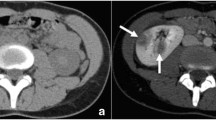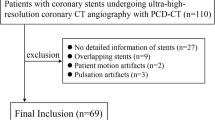Abstract
Purpose
To retrospectively evaluate the ability of computed tomographic (CT) findings to discriminate nutcracker syndrome (NCS) from asymptomatic nutcracker phenomenon (NCP) and to investigate the diagnostic value of CT findings in diagnosis of NCS.
Methods
From January 2014 to April 2015, 216 patients who underwent initial urographic CT were included. Initially, 216 patients were categorized as “nutcracker” or “normal,” based on the following CT criteria: (1) the presence of beak sign and (2) hilar-aortomesenteric left renal vein diameter ratio >4. Patients who satisfied both of these criteria were diagnosed with nutcracker. The nutcracker was then divided into “NCS” and “asymptomatic NCP” based on the presence of characteristic symptoms. CT findings in sagittal and axial scans of corticomedullary phase were evaluated. Multivariate analysis was used to identify significant factors among 30 NCS, 51 asymptomatic NCP, and 135 normal patients. Diagnostic performance and threshold using receiver operating characteristic (ROC) curve were calculated.
Results
A total of 131 males and 85 females, with mean age of 38.6 years (range 18–89 years), were included. Multivariate analysis demonstrated superior mesenteric artery (SMA)-aortic angle (p < 0.001) and visualization of a dilated collateral vein with reflux (p = 0.001) were independent factors for distinguishing NCS from asymptomatic NCP. The combination of SMA-aortic angle <25° and visualization of a dilated collateral vein with reflux provided the greatest diagnostic accuracy (area under the ROC curve, 0.841).
Conclusions
The combination of SMA-aortic angle and visualization of a dilated collateral vein with reflux in multidetector CT can be useful to differentiate NCS from asymptomatic NCP.




Similar content being viewed by others
References
Kurklinsky AK, Rooke TW (2010) Nutcracker phenomenon and nutcracker syndrome. Mayo Clin Proc 85:552–559
Fong JK, Poh AC, Tan AG, Taneja R (2014) Imaging findings and clinical features of abdominal vascular compression syndromes. Am J Roentgenol 203:29–36
Butros SR, Liu R, Oliveira GR, Ganguli S, Kalva S (2013) Venous compression syndromes: clinical features, imaging findings and management. Br J Radiol 86:20130284
Poyraz AK, Firdolas F, Onur MR, Kocakoc E (2013) Evaluation of left renal vein entrapment using multidetector computed tomography. Acta Radiol 54:144–148
Zerin JM, Hernandez RJ, Sedman AB, Kelsch RC (1991) “Dilatation” of the left renal vein on computed tomography in children: a normal variant. Pediatr Radiol 21:267–269
Hanna HE, Santella RN, Zawada ET Jr, Masterson TE (1997) Nutcracker syndrome: an underdiagnosed cause for hematuria? S D J Med 50:429–436
Grimm LJ, Engstrom BI, Nelson RC, Kim CY (2013) Incidental detection of nutcracker phenomenonon multidetector CT in an asymptomatic population: prevalence and associated findings. J Comput Assist Tomogr 37:415–418
He Y, Wu Z, Chen S, et al. (2014) Nutcracker syndrome-how well do we know it? Urology 83:12–17
Ahmed K, Sampath R, Khan MS (2006) Current trends in the diagnosis and management of renal nutcracker syndrome: a review. Eur J Vasc Endovasc Surg 31:410–416
Hohenfellner M, Steinbach F, Schultz-Lampel D, et al. (1991) The nutcracker syndrome: new aspects of pathophysiology, diagnosis and treatment. J Urol 146:685–688
Wendel RG, Crawford ED, Hehman KN (1980) The “nutcracker” phenomenon: an unusual cause for renal varicosities with hematuria. J Urol 123:761–763
Ariyoshi A, Nagase K (1990) Renal hematuria caused by “nutcracker” phenomenon: a more logical surgical management. Urology 35:168–170
Buschi AJ, Harrison RB, Norman A, et al. (1980) Distended left renal vein: CT/sonographic normal variant. Am J Roentgenol 135:339–342
Yun SJ, Nam DH, Ryu JK, Kim JS (2014) The roles of the liver and pancreas in renal nutcracker syndrome. Eur J Radiol 83:1765–1770
Kim KW, Cho JY, Kim SH, et al. (2011) Diagnostic value of computed tomographic findings of nutcracker syndrome: correlation with renal venography and renocaval pressure gradients. Eur J Radiol 80:648–654
Grossfeld GD, Litwin MS, Wolf JS, et al. (2001) Evaluation of asymptomatic microscopic hematuria in adults: the American Urological Association best practice policy–part I: definition, detection, prevalence, and etiology. Urology 57:599–603
Go AS, Chertow GM, Fan D, McCulloch CE, Hsu CY (2004) Chronic kidney disease and the risks of death, cardiovascular events, and hospitalization. N Engl J Med 351:1296–1305
Arthurs OJ, Mehta U, Set PA (2012) Nutcracker and SMA syndromes: What is the normal SMA angle in children? Eur J Radiol 81:e854–e861
Karaosmanoglu D, Karcaaltincaba M, Karcaaltincaba D, et al. (2009) MDCT of the ovarian vein: normal anatomy and pathology. Am J Roentgenol 192:295–299
Park SJ, Lim JW, Ko YT, et al. (2004) Diagnosis of pelvic congestion syndrome using transabdominal and transvaginal sonography. Am J Roentgenol 182:683–688
Yao Y, Okada Y, Yamato M, et al. (2003) Communicating vein between the left renal vein and left ascending lumber vein: incidence and significance on abdominal CT. Radiat Med 21:252–257
Hiromura T, Nishioka T, Nishioka S, et al. (2004) Reflux in the left ovarian vein: analysis of MDCT findings in asymptomatic women. Am J Roentgenol 183:1411–1415
Park SJ, Lim JW, Cho BS, Yoon TY, Oh JH (2002) Nutcracker syndrome in children with orthostatic proteinuria: diagnosis on the basis of Doppler sonography. J Ultrasound Med 21:39–45
Ozkurt H, Cenker MM, Bas N, Erturk SM, Basak M (2007) Measurement of the distance and angle between the aorta and superior mesenteric artery: normal values in different BMI categories. Surg Radiol Anat 29:595–599
Unal B, Aktas A, Kemal G, et al. (2005) Superior mesenteric artery syndrome: CT and ultrasonography findings. Diagn Interv Radiol 11:90–95
Fu WJ, Hong BF, Gao JP, et al. (2006) Nutcracker phenomenon: a new diagnostic method of multisclice CT angiography. Int J Urol 13:870–873
Cho BS, Suh JS, Hahn WH, Kim SD, Lim JW (2010) Multidetector CT findings and correlations with proteinuria in nutcracker syndrome. Pediatr Nephrol 25:469–475
Ozbulbul NI, Yurdakul M, Dedeoglu H, Tola M, Olcer T (2009) Evaluation of effect of visceral fat area on the distance and angle between the SMA and aorta. Surg Radiol Anat 31:545–549
Takebayashi S, Ueki T, Ikeda N, Fujikawa A (1999) Diagnosis of the nutcracker syndrome with color Doppler sonography: correlation with flow patterns on retrograde left renal venography. Am J Roentgenol 172:39–43
i Calàbria HC, Gómez SQ, Cerqueda CS, et al. (2005) Nutcracker or left renal vein compression phenomenon: multidetector computed tomography findings and clinical significance. Eur Radiol 15:1745–1751
Rozenblit AM, Ricci ZJ, Tuvia J, et al. (2001) Incompetent and dilated ovarian veins: a common CT finding in asymptomatic parous women. Am J Roentgenol 176:119–122
Fitoz S, Ekim M, Ozcakar ZB, Elhan AH, Yalcinkaya F (2007) Nutcracker syndrome in children: the role of upright position examination and superior mesenteric artery angle measurement in the diagnosis. J Ultrasound Med 26:573–580
Acknowledgments
We acknowledge Yong Sung Park for help with statistics.
Funding
None.
Author information
Authors and Affiliations
Corresponding author
Ethics declarations
Conflict of interest
The authors declare that they have no conflict of interest.
Ethical approval
All procedures performed in studies involving human participants were in accordance with the ethical standards of the institutional and/or national research committee and with the 1964 Helsinki declaration and its later amendments or comparable ethical standards. For this type of study, formal consent is not required (retrospective study).
Informed consent
Patients’ informed consent was waived by our hospital’s institutional review board.
Rights and permissions
About this article
Cite this article
Yun, S.J., Lee, J.M., Nam, D.H. et al. Discriminating renal nutcracker syndrome from asymptomatic nutcracker phenomenon using multidetector computed tomography. Abdom Radiol 41, 1580–1588 (2016). https://doi.org/10.1007/s00261-016-0717-8
Published:
Issue Date:
DOI: https://doi.org/10.1007/s00261-016-0717-8




